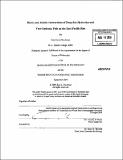Biotic and abiotic interactions of deep-sea hydrothermal vent-endemic fish on the East Pacific Rise
Author(s)
Buckman, Kate Lynn
DownloadFull printable version (12.48Mb)
Other Contributors
Massachusetts Institute of Technology. Dept. of Biology.
Advisor
Timothy M. Shank.
Terms of use
Metadata
Show full item recordAbstract
A study of the ecology of fish endemic to hydrothermal vents on the East Pacific Rise was undertaken utilizing a variety of techniques, focusing on the bythitid Thermichthys hollisi. Stable isotope and gut content analyses were used to elucidate prey choice and trophic relationships. Otolith chemical signatures were investigated to determine whether this technique could be utilized to examine life history strategy and habitat use. Chemical characteristics of preferred fish habitat and gene expression responses habitat chemistry were explored. Gut contents indicated that T. hollisi specimens were actively feeding upon a combination of brachyuran crabs, Alvinocaris shrimp, polychaetes, and zoarcid fish with the majority of fish containing evidence of crustacean prey. Carbon, nitrogen, and sulfur stable isotopic measurements support a chemosynthetically based prey source and place T. hollisi in the uppermost trophic levels of vent communities. The influence of exposure to hydrothermal fluids was apparent in otoliths from both species of vent fish, most noticeably within the relatively elevated Sr:Ca and depleted Mg:Ca ratios. Otolith chemistry suggested that the zoarcid Thermarces cerberus experiences greater direct exposure to diffuse fluids than does T. hollisi, which is concurrent with apparent habitat preferences. Isotopic patterns across the span of the otolith suggested that T. cerberus spends its entire life within the vent system. In contrast, it appeared that T. hollisi exists outside of the influence of hydrothermal activity for some early portion of its life-cycle. (cont.) Time-lapse photography and in situ electrochemistry indicated that T. hollisi are preferentially utilizing fish holes where there are elevated temperatures and sulfide levels, and variable oxygen levels in comparison to ambient bottom water. A fragment of Cu, Zn superoxide dismutase was successfully amplified from T. hollisi mRNA, but there were no differences in expression levels between tissue types or among individuals within the small sample examined. In general, it appears that T. hollisi is both influenced by and may exert a greater influence on hydrothermal vent communities to a greater degree than initially hypothesized.
Description
Thesis (Ph. D.)--Massachusetts Institute of Technology, Dept. of Biology, 2009. Cataloged from PDF version of thesis. Includes bibliographical references.
Date issued
2009Department
Massachusetts Institute of Technology. Department of BiologyPublisher
Massachusetts Institute of Technology
Keywords
Biology.